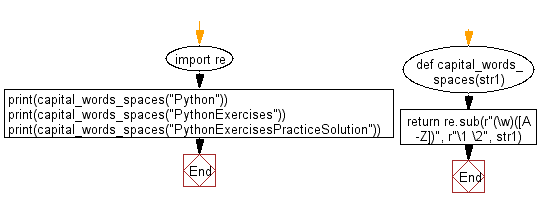
If the pattern is not found in the string, then it returns the same string.

This new string is obtained by replacing all the occurrences of the given pattern in the string by a replacement string repl. re.sub(pattern, repl, string, count0, flags0) It returns a new string.
#Alphabet rejex python code#
The above code can be reduced to fewer lines using list comprehension. Python’s regex module provides a function sub () i.e. The result string contains only letters from the original string.

# string with letters, numbers, and special characters If it is, then add the character to our result string. For each character, check if its an alphabet using the string isalpha() function.Iterate through each character in our given string.First, run the Python interpreter, import the re module, and compile a RE: > import re > p re.compile(' a-z+') > p re.compile (' a-z+') Now, you can try matching various strings against the RE a-z+. Create an empty string to store our result string with only letters. This HOWTO uses the standard Python interpreter for its examples.Here's an example: import re pattern 'a.s' teststring 'abyss' result re.match (pattern, teststring) if result: print('Search successful.') else: print('Search unsuccessful.') Run Code Here, we used re.match () function to search pattern within the teststring. Using string isalpha() functionĪlternatively, you can use the string isalpha() function to remove non-alphabet characters from the string. Python has a module named re to work with RegEx. You can see that the resulting string contains only letters. The resulting string will contain only letters. Here we will use regex to split a string with five delimiters Including the dot, comma, semicolon, a hyphen, and space followed by any amount of extra whitespace. You can use the regular expression 'r' to match with non-alphabet characters in the string and replace them with an empty string using the re.sub() function. Let’s look at both the methods with the help of examples – Extract alphabets from a string using regex You can also iterate over the characters in a string and using the string isalpha() function to keep only letters in a string. You can use a regular expression to extract only letters (alphabets) from a string in Python.
#Alphabet rejex python how to#
How to extract only alphabets from a string in Python? This problem can also be solved by employing regex to include only space and alphabets in a string. The quickest way to solve this problem is by making use of the ASCII values of each character and using pre-existing functions in Python. print('Does String contain only space and alphabets : ' + str(res)) Output : The original string is : geeksforgeeks is best for geeks Does String contain only space and alphabets : True. In this tutorial, we want to store the English alphabet’s 26 lowercase characters in a Python list. RegEx Module Python has a built-in package called re, which can be used to work with Regular Expressions.

To change the character in every iteration you can set a counter and increment it by 1 every time in the inner loop.In this tutorial, we will look at how to keep only letters (extract alphabets) from a string in Python with the help of examples. This tutorial shows you how to list the alphabet by the range in Python. To create this simply create 2 nested for loops where the outer loop repeats a row and the internal loop prints the character in a column. In the above pattern, we have 5 rows and 5 columns and the character is changing every next time. Some regex engines don't support this Unicode syntax but allow the \w alphanumeric shorthand to also match non-ASCII characters. (+) Special characters become literal inside a set, so this matches (, +,, and ). a-z0-9 Matches characters from a to z and also from 0 to 9. Now, The \s+ regex pattern will split the target string on the occurrence of one or more whitespace characters. Let’s add the + metacharacter at the end of \s. In this example, we will split the target string at each white-space character using the \s special sequence.
#Alphabet rejex python series#
Let us create all of the above square patterns one by one. a- Matches a or -, because - is not being used to indicate a series of characters. Now, let’s see how to use re.split () with the help of a simple example. Like for square pattern we can have every next character changing, character changing only in a row, character changing only in a column, etc.

Square Alphabet Pattern in PythonĪlphabet patterns with the same shape can have different types of character filling. Now we know how to loop through the alphabet in python.


 0 kommentar(er)
0 kommentar(er)
